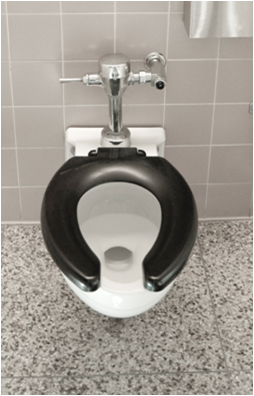by Brianna Crandall — January 15, 2016—To help schools, businesses, and other facilities save water in restrooms, the U.S. Environmental Protection Agency (EPA) has added a new category to its list of products that can earn the WaterSense label: flushometer-valve toilets, also known as “water closets” in plumbing standards. They are typically found in commercial, institutional, or industrial restrooms, in such places as airports, theaters, stadiums, schools, and office buildings.

Flushometer-valve toilets, or “water closets,” are typically found in commercial, institutional or industrial restrooms, in such places as airports, theaters, stadiums, schools and office buildings. Photo courtesy of EPA.
The new WaterSense labeling specification sets a maximum allowable flush volume of 1.28 gallons per flush (gpf), which is 20 percent less water than the federal standard. WaterSense has also incorporated a minimum flush volume of 1.0 gpf to ensure that plumbing systems have adequate flow to function effectively. For dual-flush models of flushometer-valve toilets, the maximum and minimum flush-volume requirements apply to both the full- and reduced-flush modes.
Like all WaterSense-labeled products, flushometer-valve toilets will be independently certified for water efficiency and performance. WaterSense-labeled models must also comply with existing plumbing codes and standards, and will be tested to handle typical commercial waste loads. EPA recommends that facilities managers consult a plumbing engineer if they have questions about using WaterSense-labeled flushometer-valve toilets in their building.
EPA estimates that about 26 percent — or 7 million — of the 27 million flushometer-valve toilets currently installed in U.S. commercial and institutional facilities flush at volumes higher than the federal standard of 1.6 gpf, some as much as 3 to 7 gpf. Each of these toilets that is replaced with a WaterSense-labeled model could reportedly save a business nearly 5,500 gallons of water per year and nearly $1,000 over the lifetime of the toilet.
According to EPA figures, a 10-story office building with 1,000 occupants can save nearly 1.2 million gallons of water and more than $10,000 in water costs per year by replacing inefficient flushometer-valve toilets with WaterSense-labeled models. Of those savings, nearly 870,000 gallons of water and $7,600 in water costs per year can reportedly be achieved by replacing the toilets in the women’s restrooms alone.
WaterSense already labels flushing urinals and pre-rinse spray valves used in commercial and institutional facilities. With the release of the “WaterSense Specification for Flushometer-Valve Water Closets,” manufacturers of toilet fixtures and flushometer valves that have partnered with WaterSense can have their valves, fixtures, or valve-fixture combinations certified to earn the label. Building owners, architects, and managers should be able to purchase these labeled products in early 2016.
For more information, visit the WaterSense Flushometer-Valve Toilets Web page, or see the accompanying fact sheet.





